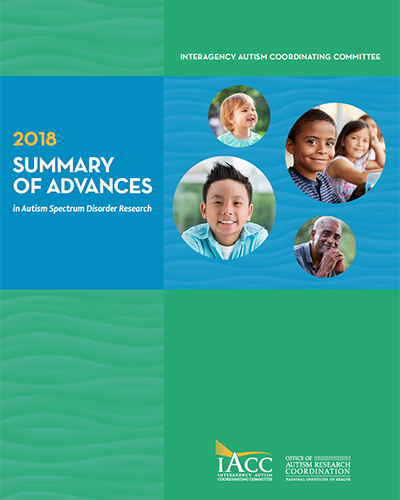Summary of Advances
In Autism Spectrum Disorder Research
2018
Effects of State Autism Mandate Age Caps on Health Service Use and Spending Among Adolescents.
Kennedy-Hendricks A, Epstein AJ, Mandell DS, Candon MK, Marcus SC, Xie M, Barry CL, et al. J Am Acad Child Adolesc Psychiatry. 2018 Feb;57(2):125-131. [PMID: 29413145]
ASD is a lifelong condition, and many people require ASD-related health care into adulthood. Many states have addressed these needs by requiring insurance companies to provide coverage for health services specific to ASD needs. However, these mandates often include age caps that allow insurers to end ASD-related service coverage for individuals who have reached adolescence. In this study, researchers considered how age caps affect use and spending of ASD-specific services among adolescents who have aged out of coverage. They hypothesized that when insurance companies stop covering outpatient services, outpatient service use will decrease, and will result in increased use of inpatient services and psychotropic medication.
The researchers gathered data on individuals aged 10 to 21 between 2008-2012 from three major commercial insurers. Using these data, researchers identified 7,845 individuals in the 11 states where mandated autism insurance coverage ended in adolescence (14 to 18 years old). Researchers compared outpatient and inpatient health service use and spending among individuals below and above the age cap to individuals in matching age groups that were ineligible for the mandated coverage in their respective states.
The researchers found that adolescents who had aged out of state mandated coverage were 4.2 percent less likely to use any ASD-specific health services and spent $69 less per month on ASD-specific services than those who were never subject to mandate provisions. They found similar results for outpatient service use, determining that individuals who exceeded the age cap were 4.1 percent less likely to use ASD-related outpatient services than the comparison group who were never subject to the age cap. However, mandated age caps were not significantly associated with increased use of ASD-related inpatient services or increased use of psychotropic medication. Although the researchers did not find that age caps significantly lowered the probability of overall health care service use, they did find that adolescents who had aged out of mandated services spent an average of $99 less per month on all health care services combined.
These findings suggest that state mandated age caps set in adolescence may significantly decrease health service usage and spending among transition-aged youth. Although these individuals may require additional services and supports as they progress towards and through adulthood, insurance age caps may lead to disruptions in continuity of care and engagement with health care systems.
Vaccination Patterns in Children After Autism Spectrum Disorder Diagnosis and in Their Younger Siblings
Zerbo O, Modaressi S, Goddard K, Lewis E, Fireman BH, Daley MF, Irving SA, Jackson LA, Donahue JG, Qian L, Getahun D, DeStefano F, McNeil MM, Klein NP. JAMA Pediatr. 2018 Mar 26. [PMID: 29582071]
Although previous research supports no association between vaccination and the development of ASD, public concerns about this connection have led to a decrease in vaccination rates among children in the United States. Currently, there is little existing research regarding vaccination patterns among family members of children with ASD. This study sought to determine whether children with ASD and their younger siblings are receiving their vaccinations on schedule and to completion. Additionally, researchers investigated if there were differences in vaccination patterns between families of children with ASD and families with no history of ASD.
In this study, the Vaccine Safety Datalink (VSD) was used to collect data from 3,729 children with ASD, 592,907 children without ASD, and their younger siblings. The researchers found that among children 4 to 6 years old, those with ASD were significantly less likely to have completed the recommended vaccine schedule than children without ASD, but both groups were equally likely to have received their recommended vaccines for ages 11 to 12 years. Moreover, younger siblings of children with ASD were less likely to have received all recommended vaccines than younger siblings of children without ASD. This difference was the greatest for younger siblings aged 1 to 11 months, and this finding was consistent for all age groups except vaccines recommended for children aged 11 to 12 years. Finally, parents of children with ASD were more likely to limit vaccinations for their younger children during the first year of life relative to parents without a child with ASD.
These findings suggest that some parents of children with ASD perceive that vaccines were at least in part responsible for the ASD diagnosis. As a result, these parents may be less likely to vaccinate their younger children during the first year of life. The results of this study indicate that the perceived association between vaccines and ASD remains a strong factor in the health care decision-making process of many parents in the United States. Additionally, the results of this study indicate that children with ASD and their siblings are at a greater risk of developing vaccine-preventable diseases.




